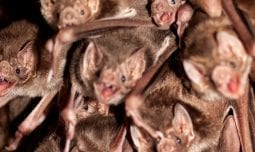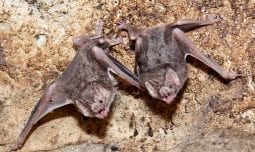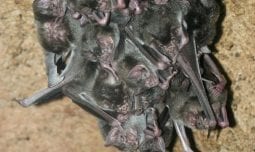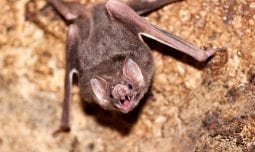Classification
Class Mammalia
Order Chiroptera
Family Phyllostomidae
Genus Desmodus
Species rotundus
Habitat & Range
Caves, mines, hollow trees or abandoned buildings in deserts, tropical or subtropical regions.
Present in Mexico south to Brazil, Chile and Argentina, and occur up to about 7,800 feet (2,400 m) in elevation.

Vampire Bat
Desmodus rotundus
Bats are the only mammals capable of sustained flight. The wings of bats are different than birds. Bats have a thin membrane of skin with bundles of elastic tissue and muscle fiber that is supported by the finger bones and extends to the arms and legs. The muscle fibers extend the wings and provide tension as the bats flap their wings in flight.
Adaptations
Just a Little Sip
Vampire bats feed almost exclusively on blood from domestic animals. After landing on or near a potential food source, they use their razor sharp incisors to make a tiny, painless cut in the skin of the animal. Their saliva contains an anti-coagulant called “draculin” that keeps blood flowing from the wound. They do not suck blood but rather use their grooved tongue to lap up the free-flowing blood. A vampire bat may ingest up to 40 percent of its body weight while feeding. With such a huge increase in body weight, vampire bats would not be able to fly after a meal if it were not for their ability to rapidly process and digest the blood.
Ultrasonic Navigation
Common vampire bats are active only during the darkest hours of the night. In the darkness, they use echolocation to find food and to avoid collisions when flying. Bats produce ultrasonic (high frequency) sounds that are not audible to humans. Echolocation is the ability to bounce these sound waves off objects so the returning sound waves provide information about food sources and potential hazards. Vampire bats also have very good hearing, excellent vision and a well-developed sense of smell, all of which aid in finding food.
I Can Fly!
The wings of bats are different than birds, as a result bats are the only mammals capable of sustained flight. Bats have a thin membrane of skin with bundles of elastic tissue and muscle fiber that is supported by the finger bones and extends to the arms and legs. The muscle fibers extend the wings and provide tension as the bats flap their wings in flight, then fold the wings in when they rest.
Physical Description
- The vampire bat’s head and body length is two to three inches (6.5-9 cm).
- They weigh one-half to one-and-a-half ounces (15-45 g).
- They have a grizzled, gray-brown, furry coat.
- They have an eight-inch (20 cm) wingspan.
- They have a short rounded muzzle, large ears, and a thumb claw on the front of the wing.
Diet
What Does It Eat?
In the wild: Blood from domestic animals such as cows, donkeys, pigs and horses.
At the zoo: Beef blood.
What Eats It?
Eagles, owls and hawks prey on the vampire bat.
Social Organization
Bats are very social animals living in colonies of hundreds or even thousands of bats. Within the colonies there are subgroups consisting of breeding males with around twenty females and their offspring. Bats spend hours grooming themselves and social grooming usually takes place between closely related females, or females and their young. Bats will even share blood with other colony members who weren’t successful at finding prey.
Life Cycle
Vampire bats are sexually mature at nine months of age. Mating occurs year round, and pregnant bats roost together in a nursery group. After a gestation of 205-214 days, females give birth to a single pup weighing about two-tenths of an ounce (5-7 g); twins are rare. The mother carries the pup for the first few days of life. Pups feed primarily on the mother’s milk for the first month using specialized milk teeth. At two months of age, the pups begin getting regurgitated blood, and at about four months of age the pups begin accompanying their mother to feed on blood. At nine months the pup is mature, males will leave the roost, and females stay with their mother’s roost. Vampire bats live up to nine years in the wild and up to 20 years in captivity.
Fun Facts
- Bats are the only mammals that can fly.
- A drug developed from research on the anti-coagulant properties of bat saliva is used to prevent blood clots in heart and stroke patients.
- Unlike other bats, the vampire bat can walk, run and hop along the ground to stalk its prey.
Conservation Status
IUCN Status: Lower Risk-Least Concern
Vampire bats are not currently endangered. They are affected by loss of habitat and sometimes killed because of the risk of transmitting rabies to domestic animals.

Download the App!
Get the FREE Denver Zoo app today, and be a pro the next time you visit the Zoo. You’ll get access to the Zoo map, daily activities and schedules, animal facts, and more. You can even load your membership card onto the app for additional convenience. It puts everything you need for an amazing Zoo experience right into the palm of your hand!



